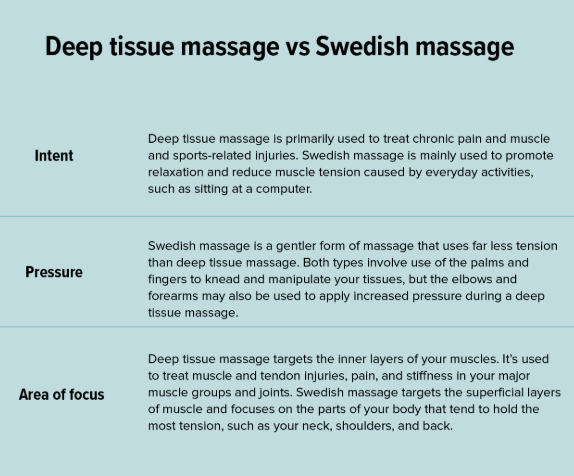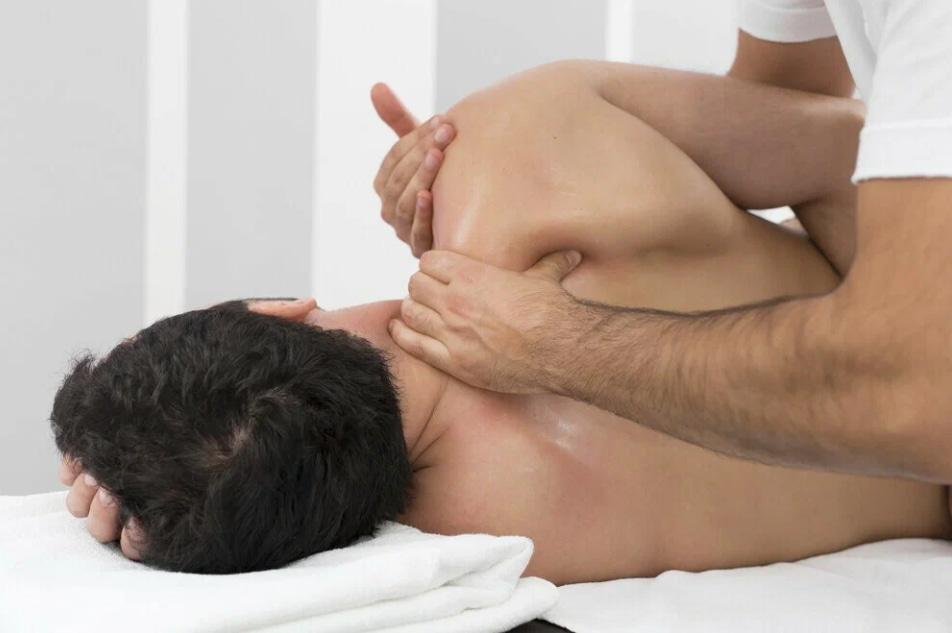Table of Contents
Deep tissue massage is a popular therapy that helps tackle both physical and mental stress. Known for relieving muscle pain and tension, this technique also promotes relaxation, offering benefits that can improve your overall well-being.
But what exactly is a deep tissue massage? This therapeutic method focuses on applying sustained pressure using slow, deep strokes to reach the innermost layers of muscles and connective tissues.
It helps break up scar tissue, reduce stiffness, and boost healing by increasing blood flow. Whether you deal with chronic pain, injuries, or stress, deep tissue massage can provide much-needed relief.
Here’s everything you need to know about deep tissue massage, from its methods to its benefits and potential dangers.
Deep Tissue Massage Benefits
Deep tissue massage offers a range of advantages, tackling both physical issues like muscle pain and mental challenges like stress. Here are its key benefits:
- Pain Relief
This therapy is particularly effective for people dealing with chronic pain or injuries. A 2014 study highlighted deep tissue massage’s ability to reduce pain in those with chronic low back pain, comparing it to nonsteroidal anti-inflammatory drugs like ibuprofen. The firm pressure applied during the massage loosens tight muscles while targeting deeply embedded tension. - Improved Muscle Stiffness
Tight muscles can impact your range of motion and daily activities. Deep tissue massage helps stretch and relax these muscles, improving flexibility and reducing stiffness. - Supports Healing
The technique promotes faster healing by improving blood flow and reducing inflammation. It’s especially beneficial for sports injuries. - Stress Reduction
Though primarily focused on physical benefits, a deep tissue massage can also be surprisingly calming. It induces a sense of relaxation, which helps manage anxiety and mental fatigue. - Weight Loss Benefits
Interestingly, some proponents suggest that deep tissue massage fosters weight loss. It works by improving metabolism, reducing cortisol (a stress hormone), and potentially supporting better digestion.
Read Also:
- Is Cream of Wheat Healthy? — Learn how this popular breakfast choice can be a nutritious addition to your diet.
- 9 Ways to Help a Teething Baby Sleep — Discover effective methods to soothe your baby and ensure a peaceful night’s sleep.
How does it compare to Swedish massage?
Deep tissue massage and Swedish massage are two different types of massage therapy. Both use some of the same strokes, but they have different uses and vary greatly when it comes to the amount of pressure used.
Here are the key differences between deep tissue massage and Swedish massage:

Deep Tissue Massage Techniques
Deep tissue massage techniques involve slow, deliberate strokes and firm pressure on specific areas of the body. The goal is to work deeply into the layers of muscle and fascia to release chronic tension.
A skilled therapist may even use their forearms or elbows, a method often called “deep tissue massage using elbow,” to apply more intense pressure.
Your therapist will begin by warming up the muscles using lighter strokes to prepare your body for deeper work. Once ready, they’ll focus on problem areas, using kneading and stroking techniques.
Sustained pressure and friction are often applied to specific points of tension. Be sure to communicate your comfort level throughout the session, so they can adjust if needed.
What is a Deep Tissue Massage Best For?
This therapy is an excellent choice for active individuals or those struggling with issues like chronic pain. Common conditions treated by deep tissue massage include:
- Sports injuries
- Fibromyalgia
- Sciatica
- Plantar fasciitis
- High blood pressure
- Tennis elbow
If you’re dealing with persistent discomfort due to physical strain, deep tissue massage might be the solution. However, it’s not for everyone.
Dangers of Deep Tissue Massage
While deep tissue massage has valuable benefits, it does come with risks. It involves the application of firm pressure, which isn’t suitable for everyone. Here are some possible dangers of deep tissue massage to consider:
- Bruising or Soreness
A common side effect is mild soreness or bruising post-session, especially if you’re new to intense pressure. Applying heat or ice may help with this. - Not Recommended for Certain Conditions
People with blood clotting issues, osteoporosis, cancer, or those on blood thinners should avoid deep tissue massage. These conditions increase the risk of complications, such as fractures or internal bleeding. - Pregnancy Concerns
Pregnant women should avoid deep tissue massage. Instead, a gentler option like Swedish massage is a safer alternative during pregnancy.
If you have a medical condition, it’s best to consult your doctor before booking a session.
Disadvantage of Deep Tissue Massage
Despite its advantages, there are potential downsides. One of the biggest issues is that it can be quite uncomfortable, especially for those unused to firm pressure. The technique may also cause minor swelling or tenderness.
Additionally, deep tissue massage may not target relaxation as effectively as techniques like Swedish massage. If your primary goal is to de-stress rather than tackle physical discomfort, you might prefer a gentler treatment.
What to Expect During a Session
Before beginning, your therapist will ask about problem areas or physical concerns. Depending on your needs, the session may focus on your whole body or specific regions.
You’ll be asked to lie down, typically undressed to your comfort level, with a sheet or towel covering your body.
After this, your therapist will warm up your muscles before proceeding with deeper strokes. Techniques such as kneading, friction, and using elbows or forearms will be employed to target tension effectively.
Remember, open communication is crucial. If the pressure feels uncomfortable, don’t hesitate to say so.
Finding the Right Therapist
Choosing a qualified massage therapist is essential. When searching, keep these tools in mind:
- Ask for recommendations from friends or healthcare providers.
- Check credentials to ensure they’re licensed and well-trained.
- Clarify their areas of expertise to confirm they specialize in deep tissue massage.
Also, consider the cost per session and whether your insurance covers massage therapy, especially if prescribed for specific conditions.
Final Thoughts
Deep tissue massage is ideal for individuals dealing with injuries, chronic pain, or high physical demand. While the therapy offers a wealth of benefits, it’s crucial to be aware of potential risks.
Whether you’re exploring deep tissue massage benefits for weight loss or need a solution for muscle discomfort, consulting a professional therapist or doctor is step one.
For best results, find a massage therapist you trust and openly communicate your personal needs and comfort level. With the right approach, deep tissue massage can significantly enhance how you feel, move, and heal.
For More Health Remedies visit: Remedyu.com
